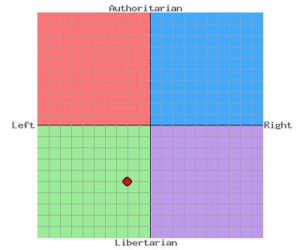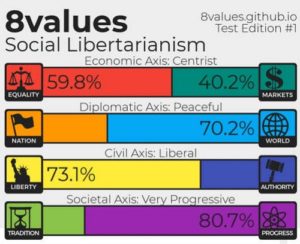I generally find political labels to be rather pointless and I don’t consider myself to be a member of any political party. I also acknowledge that any political positioning on any scale is largely a matter of perspective. That said, I have indeed self-identified as “a little left of center” within this blog. While I stand by that overly broad characterization, some readers have questioned my underlying rationale.
In the interest of full disclosure, I thought some further insight might be appropriate. (Nah. I really don’t give a crap about full disclosure. I just find political positioning to be an interesting topic.)
There are various online quizzes that attempt to derive some definitive placement on various political spectra. Most of them are a waste of time since the multiple choice format doesn’t allow much room for nuanced answers. However, I do find two of these methodologies to be somewhat interesting.
In this blog’s previous incarnation, I published a link to the Political Compass. Recognizing that “left/right” is itself a flawed scale, the Political Compass attempts to classify a respondent within a two-dimensional grid – using the horizontal axis to represent economic positions and the vertical axis to represent social positions.
The compass currently uses a 62 question survey to derive a grid coordinate. The grid itself is very Euro-centric – representing a political spectrum that is much broader on the other side of the pond. While U.S. Republicans would be generally positioned to the upper right of U.S. Democrats, almost all mainstream American politicians would find themselves in the upper right quadrant of the international grid. Within that context, the compass has been around since 2001 and still seems useful.
Numerous attempts to position various politicians and parties on the Political Compass can be found online, but here’s what looks like a rationale take from the 2012 and 2016 U.S. election cycles:

Here’s my personal results from November 2007:

I recently retook the test (almost 11 years later) and the compass positions me in virtually the same spot today. Hey, at least I’m consistent! And I can’t really argue a whole lot with the result.
Another characterization attempt is 8values. This methodology uses a 70 question survey to position a respondent on four separate axes, each with its own a linear scale bookended by two opposing values. The axes and their respective values are Economic (Equality vs. Markets), Diplomatic (Nation vs. World), State (Liberty vs. Authority), and Society (Tradition vs. Progress).
Here’s my results:

8values also tells me that I’m a Social Libertarian – whatever the hell that means. Again, I’m not fond of labels. However, the general placements on the four axes seem reasonable enough.
I’d be interested to hear if others find these to produce more-or-less accurate results.